Kristine Hughes's Blog, page 170
November 5, 2010
The Burney Society in Portland, Oregon
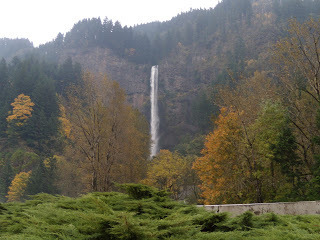
Victoria here, just back from the meetings of The Burney Society and the Jane Austen Society in Portland, OR. We went out a day early in order to take in the Columbia River Gorge. Sadly, it was raining, but not very hard. In fact, it reminded me of most English rain, not quite a mist but not a downpour either. At right is Multnomah Falls, most spectacular of the many waterfalls along the gorge. .
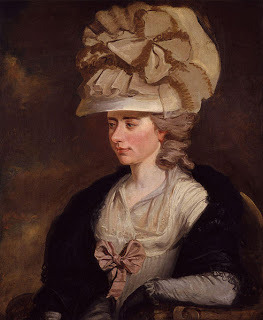 Fanny Burney (1752-1840) was the daughter of a celebrated musician and composer Dr. Charles Burney. Her half sister, Sarah Harriet Burney, was also a successful author of seven novels. Fanny Burney grew up in a household that often hosted brilliant circle of artistic and literary leaders. She kept a famous journal throughout most of her life and wrote four novels, many plays and other works.
Fanny Burney (1752-1840) was the daughter of a celebrated musician and composer Dr. Charles Burney. Her half sister, Sarah Harriet Burney, was also a successful author of seven novels. Fanny Burney grew up in a household that often hosted brilliant circle of artistic and literary leaders. She kept a famous journal throughout most of her life and wrote four novels, many plays and other works.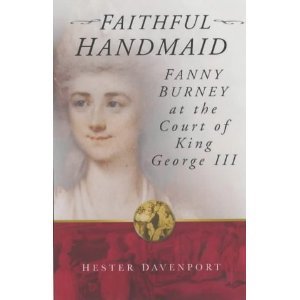 Our friend Hester Davenport, (see our posts about visiting her in Windsor last June) is a leading member of the UK's Burney society and the author of Faithful Handmaid, which relates the story of Burney's position as a Keeper of the Robes for Queen Charlotte from 1786 to 1791. The position, while prestigious, gave Burney little time to pursue her writing career. We reported on our days with Hester Davenport on July 16 and 18, 2010 posts.
Our friend Hester Davenport, (see our posts about visiting her in Windsor last June) is a leading member of the UK's Burney society and the author of Faithful Handmaid, which relates the story of Burney's position as a Keeper of the Robes for Queen Charlotte from 1786 to 1791. The position, while prestigious, gave Burney little time to pursue her writing career. We reported on our days with Hester Davenport on July 16 and 18, 2010 posts.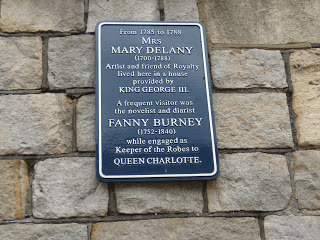 At left is my picture of a plaque on the castle wall in Windsor commemorating the lives of Mrs. Delaney (see our posts of 9/30 and 10/6/10) and Fanny Burney and their roles in the royal court.
At left is my picture of a plaque on the castle wall in Windsor commemorating the lives of Mrs. Delaney (see our posts of 9/30 and 10/6/10) and Fanny Burney and their roles in the royal court.
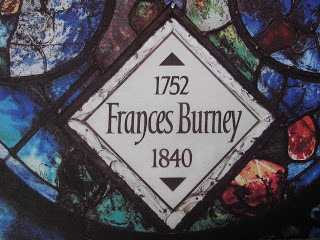 The Burney Society was proud to dedicate a window in Westminster Abbey to Frances Burney a few years ago. Our president for sixteen years has been Paula Stepankowsky (see photo below), whose leadership has been outstanding. This year the society has grown large enough to separate the UK and North American branches. Click here for more information on the McGill University Burney Center.
The Burney Society was proud to dedicate a window in Westminster Abbey to Frances Burney a few years ago. Our president for sixteen years has been Paula Stepankowsky (see photo below), whose leadership has been outstanding. This year the society has grown large enough to separate the UK and North American branches. Click here for more information on the McGill University Burney Center.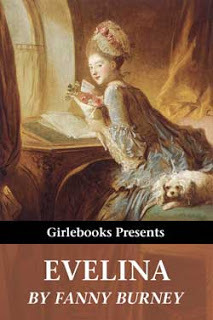 For information on the North American Burney Society and the upcoming meetings of the group, click here. Fanny Burney's first novel might be her most famous, the coming of age story of Evelina, a delightful tale with incredibly detailed accounts of late 18th century life in Britain. My favorite is Camilla, perhaps because I read it first and loved every page. All this is a long way of introducing the conference in Portland. The subject was "Burney and the Gothic." Many speakers adressed aspects of this fascinating subject in Burney's novels, finding many gothic references where I had entirely missed them! But viewed in the context of the popular genre of gothic novels in the late 18th and early 19th centuries, of course all of these arguments made obvious sense (not to mention sensibility!).
For information on the North American Burney Society and the upcoming meetings of the group, click here. Fanny Burney's first novel might be her most famous, the coming of age story of Evelina, a delightful tale with incredibly detailed accounts of late 18th century life in Britain. My favorite is Camilla, perhaps because I read it first and loved every page. All this is a long way of introducing the conference in Portland. The subject was "Burney and the Gothic." Many speakers adressed aspects of this fascinating subject in Burney's novels, finding many gothic references where I had entirely missed them! But viewed in the context of the popular genre of gothic novels in the late 18th and early 19th centuries, of course all of these arguments made obvious sense (not to mention sensibility!). 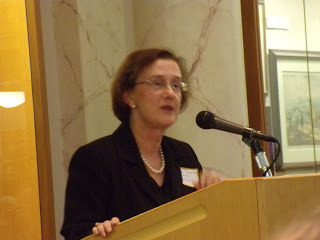 Our intrepid leader, Paula LaBeck Stepankowsky, president of The Burney society for 16 years, has been a true inspiration to all of those who love Burney, from reader/writers like me, to fond fans, to academic specialists in 18th century fiction. Paula is leaving her office and everyone was both disappointed that she will no longer be our active leader, but happy that she completed so many years of service and is moving on to a new role, which she promised would definitely include her love of Frances Burney. In
Our intrepid leader, Paula LaBeck Stepankowsky, president of The Burney society for 16 years, has been a true inspiration to all of those who love Burney, from reader/writers like me, to fond fans, to academic specialists in 18th century fiction. Paula is leaving her office and everyone was both disappointed that she will no longer be our active leader, but happy that she completed so many years of service and is moving on to a new role, which she promised would definitely include her love of Frances Burney. In 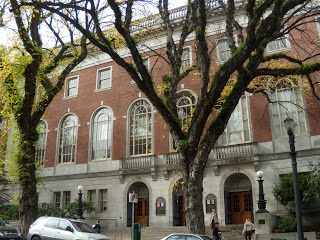 Portland Public Libraryaddition to her role in guiding the Burney Society, Paula has amassed a stellar collection of first editions and memorabilia of the late 18th and early 19th centuries, many displayed at a special exhibition at Portland's beautiful public library, a short walk from the conference hotel.
Portland Public Libraryaddition to her role in guiding the Burney Society, Paula has amassed a stellar collection of first editions and memorabilia of the late 18th and early 19th centuries, many displayed at a special exhibition at Portland's beautiful public library, a short walk from the conference hotel.
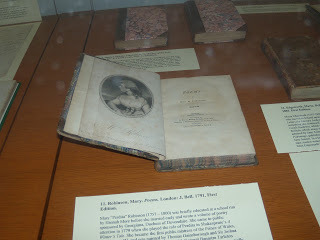 Works of Mary Robinson, 1st edition
Works of Mary Robinson, 1st edition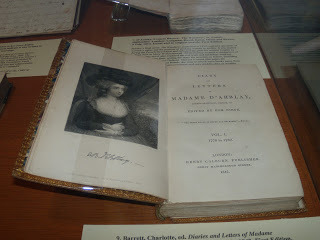 Letters of Frances Burney, Madame D'Arbly
Letters of Frances Burney, Madame D'Arbly
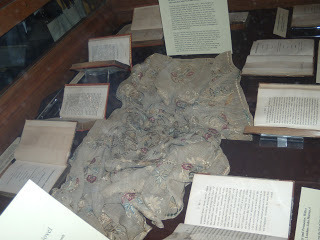 First editions of Emma and Mansfield Park beside a shawl,
First editions of Emma and Mansfield Park beside a shawl,of linen, according to family tradition, embroidered by Jane Austen
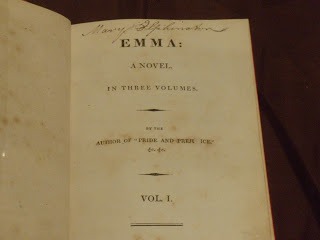 Emma, a first edition, in the collection of Paula LaBeck Stepankowsky
Emma, a first edition, in the collection of Paula LaBeck Stepankowsky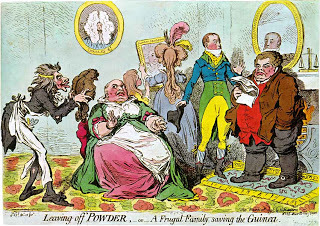
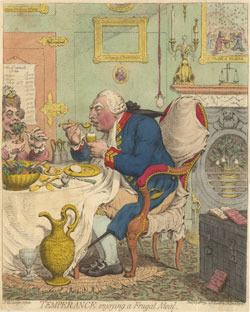
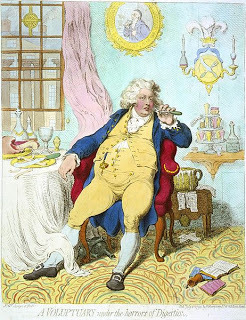 Above, copies of three of Paula's fascinating collection of Regency-era prints and charicatures by James Gillray and Thomas Rowlandson.
Above, copies of three of Paula's fascinating collection of Regency-era prints and charicatures by James Gillray and Thomas Rowlandson.What a marvelous two days. Soon, I will tell you about the following days at the Jane Austen Society of North America's Annual General Meeting: Jane Austen and the Abbey: Maystery, Mayhem, and Muslin in Portland. Stay tuned.
Published on November 05, 2010 06:57
November 4, 2010
The Prize Fighter Buried in Westminster Abbey
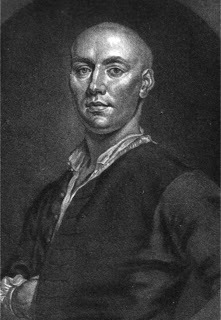 A prize fighter buried in Westminster Abbey? Can this be true? The pugilist in question is no other than Jack Broughton (at left), who is often described as the founder of the British School of Boxing. "Broughton's Rules " were long held sacred in the prize-ring, and are still regarded as the alphabet of pugilistic law.
A prize fighter buried in Westminster Abbey? Can this be true? The pugilist in question is no other than Jack Broughton (at left), who is often described as the founder of the British School of Boxing. "Broughton's Rules " were long held sacred in the prize-ring, and are still regarded as the alphabet of pugilistic law.Born in I704, Broughton began his career as a Thames waterman, and he was the first man who won Doggett's Coat and Badge. He made his appearance as a professor of self defence at George Taylor's famous booth at the "Adam and Eve " at the head of the Tottenham Court Road. There he defeated his master, and was encouraged to set up a larger and more convenient amphitheatre on his own account. Seceding from the Tottenham Court Road establishment, he rapidly built a new prize-ring adjoining the Oxford Road, near the spot where Hanway Street, Oxford Street, now stands, and opened it on March 10, I743. From prints in the British Museum, it appears that this building was somewhat similar to Astley's original circus and riding school in the Westminster Road; there were boxes, pit, and a gallery; a stage for the combatants in the centre of the ring, and the tout ensemble bore some resemblance to the pictures of the Old Fives Court in Windmill Street.
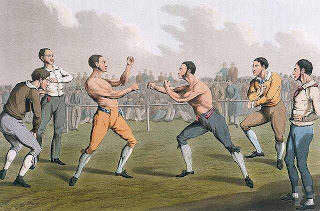
The most significant sign of Broughton's success was the promulgation of his own "Code" for the guidance of combatants, and the satisfaction of the judges. This was produced by Mr. Broughton, for the better regulation of the amphitheatre, and approved of by the gentlemen, and agreed to by the pugilists, August 18th, 1743. These rules lasted in perfect integrity from the period of their date until 1838, when after the fight between Owen Swift and Brighton Bill, the " New Rules of the Ring " superseded Broughton's. We here give the original
BROUGHTON'S RULES
(I) That a square of a yard be chalked in the middle of the stage; and every fresh set-to after a fall, or being parted from the rails, each second is to bring his man to the side of the square, and place him opposite to the other; and till they are fairly set-to at the lines, it shall not be lawful for the one to strike the other.
(2) That, in order to prevent any disputes, the time a man lies after a fall, if the second does not bring his man to the side of the square, within the space of half a minute, he shall be deemed a beaten man.
(3) That, in every main battle, no person whatever shall be upon the stage, except the principals and their seconds; the same rule to be observed in bye-battles, except that in the latter, Mr. Broughton is allowed to be upon the stage to keep decorum, and to assist gentlemen in getting to their places; provided always, he does not interfere in the battle; and whoever presumes to infringe these rules, to be turned immediately out of the house. Everybody is to quit the stage as soon as the champions are stripped, before they set-to.
(4) That no champion be deemed beaten unless he fails coming up to the line in the limited time; or that his own second declares him beaten. No second is to be allowed to ask his man's adversary any questions or advise him to give out.
(5) That, in bye-battles, the winning man to have two-thirds of the money given which shall be publicly divided upon the stage, notwithstanding any private agreements to the contrary.
(6) That, to prevent disputes, in every main battle, the principals shall, on the coming on the stage, choose from among the gentlemen present two umpires, who shall absolutely decide all disputes that may arise about the battle; and if the two umpires cannot agree, the said umpires to choose a third, who is to determine it.
(7) That no person is to hit his adversary when he is down, or seize him by the ham, the breeches, or any part below the waist; a man on his knees to be reckoned down.
These rules have been called the groundwork of fair play and manly boxing, and no man, from his experience, was better able to frame such a code than Broughton. To them, says the author of "Fistiana," we greatly owe "that spirit of fair play which off ers so wide a contrast to the practices of barbarous ages, when every advantage was admissible where brute strength or accidental casualties placed a combatant in the power of his antagonist. It is to be lamented that, even in modern times, the inhuman practices of uncivilised periods have subsisted to a disgraceful extent, and hence we have heard of gouging, that is to say forcing out the eye of an antagonist with the thumb or finger; purring, kicking a man with nailed shoes as he lies on the ground, striking him in vital parts below the waistband, seizing him when on his knees, and administering punishment till life be extinct, and a variety of other savage expedients by which revenge or passion has been gratified; and it is remarkable that in those counties in which pugilism or prizefights have been least encouraged, these horrors have been most frequent ; we refer to -shire in particular, where, even to this day, that species of contest, called up-and-down fighting, that is when a man has got down he is kept down and punished, incapable of motion, is permitted with impunity, unless indeed the death of the victim leads to the apprehension and trial of the survivor."
To Broughton also the Ring owed the introduction of gloves. He thus announced his new invention in the Daily Advertiser of February 1747 -
Mr. Broughton proposes, with proper assistance, to open an academy at his house in the Haymarket, for the instruction of those who are willing to be initiated in the mystery of boxing, where the whole theory and practice of that truly British art, with all the various stops, blows, cross-buttocks, &c., incident to combatants, will be fully taught and explained; and that persons of quality and distinction may not be debarred from entering into a course of those lectures, they will be given with the utmost tenderness and regard to the delicacy of the frame and constitution of the pupil; for which reason mufflers are provided, that will effectually secure them from the inconveniency of black eyes, broken jaws, and bloody noses.
Broughton, after fighting several years, and maintaining his ascendancy, was at length vanquished by one JackSlack, a Norwich butcher, in April I750, at Broughton's Amphitheatre. Some thousands were lost on the unexpected defeat; and nearly 150 pounds were taken at the door, not counting many tickets sold at a guinea and a half each, all of which went to Slack, who is supposed to have gained nearly 600 pounds by his victory. After this defeat Broughton never fought again; and his amphitheatre was shortly after shut up. The Duke of Cumberland, his principal patron and backer lost 10,000 pounds on this contest.
Broughton died, January 8, I789, at Walcot Place, Lambeth, in his eighty-fifth year.
Captain John Godfrey, who wrote a " Treatise on the Science of Defence," thus apostrophises Broughton:
"Advance, brave Broughton! Thee I pronounce Captain of the Boxers. As far as I can look back, I think I ought to open the characters with him ; I know none so fit, so able, to lead up the van. This is giving the living preference to the rest. What can be stronger than to say that, for seventeen or eighteen years, he has fought every able boxer that appeared against him, and has never yet been beat ? This being the case, we may venture to conclude from it ; but, not to build alone on this, let us examine further into its merits. What is it that he wants ? Strength equal to what is human, skill and judgment equal to what can be acquired, undebauched wind, and a bottom spirit never to pronounce the word 'Enough.'
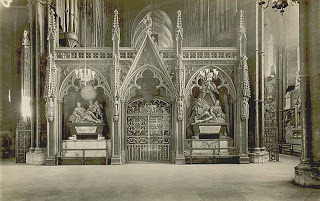
Although many authorities, including the " Dictionary of National Biography," once stated that John Broughton was buried in Lambeth Church, the father of modern boxing sleeps peacefully with his wife in the cloister of Westminster Abbey.
In the first place it is well to remember that Broughton, after his retirement from the Ring, filled an honourable place in the Yeomen of the Guard, which he held until his death. In Dean Stanley's "Historical Memorials of Westminster Abbey " it is clearly indicated that Broughton is buried in the West Cloister. His burial here is attested both by a wall tablet and a gravestone in the pavement. Here is the inscription on the wall tablet -,
BENEATH THIS TABLET LIES THE REMAINS OF MRS. ELIZABETH BROUGHTON. DIED 7TH DECEMBER, 1784- AGED 59 YEARS. ALSO OF MR. JOHN BROUGHTON, ONE OF HIS MAJESTY'S USHERS OF THE YEOMEN OF THE GUARD. DIED 8TH JANUARY, I789. AGED 86 YEARS.
When it was first erected, the stone showed a gap left after John Broughton's name. Dean Stanley tells us, on the authority of a communication made by Broughton's son-in-law to the master mason of the Abbey, that this gap was intended to be filled by the words "Champion of England." But the Dean objected, and the blank remains." His headstone did not bear an epitaph for nearly 200 years and it was not until 1988 that Broughton's request was fulfilled and the words "Champion of England" were engraved on the headstone.
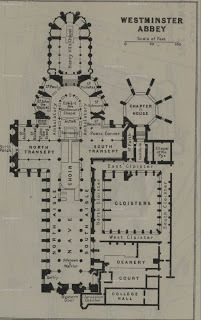
Broughton was buried in the cloister on the lefthand side of his wife (whose burial here in 1784 is itself strong presumptive evidence that her husband was laid here in 1789), but it remarks that whereas "the journals of the day state that he was buried in Lambeth churchyard " it appears that he was given an honourable interment in the Abbey.' It will be observed that on the tablet Broughton is described as one of His Majesty's Yeomen of the Guard. Several such Yeomen are buried in the cloisters, and there is even ground for believing that in his later years Broughton was also a verger of the Abbey. Indeed, Westminster Abbey may be said to contain a statue of Broughton, for the magnificent figure of Hercules in Rysbrack's monument to Sir Peter Warren in the North Transept was modelled after his gigantic form.
Published on November 04, 2010 01:39
November 3, 2010
Heads Up On Downton Abbey
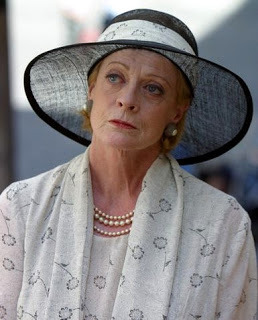
ITV will be broadcasing a new costume drama series, Downton Abbey, written and created by Oscar-winning writer Julian Fellowes and starring Maggie Smith as Violet, Dowager Countess of Grantham, Hugh Bonneville as Robert, Earl of Grantham and Elizabeth McGovern as Robert's wife, Cora, Countess of Grantham. By the way, there was a real-life Earl of Grantham, a cousin of William III, but the title became extinct when he died in 1754.
The new series, very much a la Upstairs, Downstairs, is set in an Edwardian country house in 1912 and follows the Crawley family and the servants who work for them. The Earl is married to an American and they have three daughters - a fact which presents all manner of problems when it comes to the vexed question of who will continue the Crawley line.
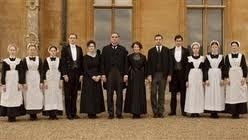
The fictional Crawleys have been the Earls of Grantham since 1772 and occupy the upstairs rooms, whilst
below stairs are other residents, the servants, as fiercely possessive of their ranks as anyone above. Some of them are loyal to the family and are committed to Downton as a way of life, others are moving through, on the look out for new opportunities or love or just adventure. The difference being that they know so many of the secrets of the family, while the family knows so few of theirs.
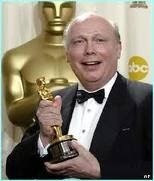 Downton Abbey's writer and creator is Julian Fellowes (at left), who also wrote Gosford Park and The Young Victoria, recently said: "It is no secret that I am fascinated by the extraordinary variety of people that occupied the great country houses. Where men and women worked alongside each other and lived in close proximity, but were separated in their dreams and aspirations by a distance that makes the moon seem close. Television drama often relies on a structure that will involve characters of different backgrounds, any hospital soap opera or detective series can give you that, but there is no narrative base that can provide members of every level of society, sleeping under a single roof, more believably than a great house before the First War. "
Downton Abbey's writer and creator is Julian Fellowes (at left), who also wrote Gosford Park and The Young Victoria, recently said: "It is no secret that I am fascinated by the extraordinary variety of people that occupied the great country houses. Where men and women worked alongside each other and lived in close proximity, but were separated in their dreams and aspirations by a distance that makes the moon seem close. Television drama often relies on a structure that will involve characters of different backgrounds, any hospital soap opera or detective series can give you that, but there is no narrative base that can provide members of every level of society, sleeping under a single roof, more believably than a great house before the First War. "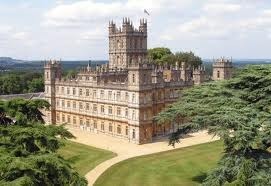
Downton Abbey itself will be played by Highclere Castle. Executive Producer and Managing Director of Carnival Films, Gareth Neame said: "Highclere Castle is the perfect location for the family home in our drama. The estate is absolutely breathtaking and the house itself is splendid beyond belief. Julian had Highclere in mind when he was writing the script and we are thrilled that Lord and Lady Carnarvon have agreed to allow us to invade their beautiful home and grounds for the duration of our shoot."
The village locations were shot in Bampton, Oxfordshire. Producer Nigel Marchant said: "Downton Abbey is supposed to be set in Yorkshire, and we needed to be able to create a fictional village nearer London. Bampton is perfect because it is so well preserved, and you hardly need to do anything in terms of alterations. There are three big manor houses which make perfect locations and we will be using different parts of the village."
The series has been airing in seven installments in Britain, which means we probably won't have the pleasure of seeing it for about a year. It has proved popular across the pond and a second series has been commissioned. However, not all is rosey with the production, as recently Julian Fellowes has been accused of lifting certain plotlines and devices straight from Little Women and other works. In addition, viewers have written to complain about historical inaccuracies, including seeing t.v. aerials on roofs and double yellow lines on the roads. You can read the full story in The Telegraph.
Published on November 03, 2010 01:17
November 2, 2010
An Evening with Ian Kelly
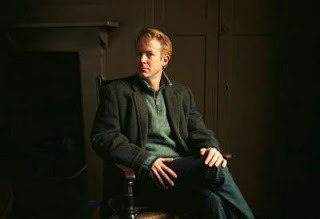
Whilst in New York recently, I finally had to opportunity to meet with actor/author Ian Kelly. I was introduced to Ian through our mutual friend, Jo Manning. Ian and I had previously spoken on the telephone and emailed, but we'd never actually met as the fates inevitably ruined any plans we'd made to get together on either side of the pond. Therefore, it was a decided pleasure to actually take in a performance of Ian's new play, The Pitmen Painters, and to finally have a drink and a chat with Ian afterwards.
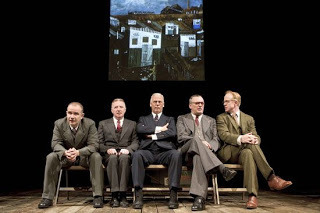 Christopher Connel, from left, David Whitaker, Deka Walmsley, Michael Hodgson and Ian Kelly
Christopher Connel, from left, David Whitaker, Deka Walmsley, Michael Hodgson and Ian Kelly Direct from a sold-out engagement at London's National Theatre, this fascinating new play by Tony Award winner Lee Hall (writer of Broadway's mega-hit Billy Elliot) comes to Broadway with its entire original London cast intact. The Pitmen Painters is based on the triumphant true story of a group of British miners who discover a new way to express themselves and unexpectedly become art-world sensations. Ian plays Robert Lyon, who was hired to teach the men about art appreciation and whose efforts afford the group an entirely new way of looking at both art and their lives.
Of course, The Pitmen Painters wasn't Ian's first turn on the boards. He's appeared in many other productions, many of them one-man shows.
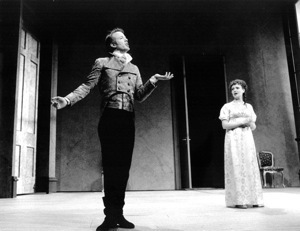
Ian has appeared in A Busy Day, the lost comedy by Fanny Burney commissioned by Sheridan for the 1800 season at Covent Garden that played first in Bristol in 1994 and then on the London fringe in 1995 before its eventual West End production in 2000. Ian played Frank Cleveland in both productions and helped champion the plays' West End premiere, which he co-produced.
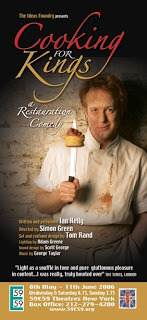
In a scene in The Pitmen Painters, Ian, as Lyon, actually creates a sketch of Oliver Kilbourn, the most gifted artist among the miners, whilst on-stage. The audience watches the sketch progress. Whilst the fact that Ian can draw while acting is amazing, it's nothing compared to the multi-tasking he did during the 2004 run of Cooking for Kings, a play based on Ian's biography of French chef Antonin Careme adapted for the new York stage as a one-man show; part of the first Brits Off Broadway Festival. In addition to acting, Ian both cooked and fed the audience.
A review by New York Theater Wire said: 'Kelly's performance is as tart as a lemon, as sweet as chocolate, as savory as a thick stew. And finally, it is as satisfying as a banquet. From early childhood most people learn to equate food with love. But few take the metaphor to the same extremes as legendary French chef Antonin Careme, whose life story is told in Ian Kelly's one-man-show "Cooking for Kings." Kelly fills his play with tantalizing details and garnishes them with ironic wit and clever wordplay. As a performer, Kelly has boundless energy and tremendous powers of concentration and he makes a technically difficult play look deceptively easy. While Careme, who is actually cooking, grabs bowls, pots and utensils from an overhead rack and chops, stirs and heats, he describes his activities with the zest of Julia Child. And Careme is accomplished at multitasking. He is never at a loss for words. He never loses his train of thought. If Careme's story is fascinating because of the famous people he knew, the tumultuous times he lived in and the many innovations he made in the art of cooking (from the dishes he made to the hat he wore), it is powerful on a more personal level. Kelly portrays the great chef as vain and sarcastic but also vulnerable and ultimately tragic.'
Anthony Bourdain called the play: 'A magnificent work. Ian Kelly is at the vanguard of the new rock'n'roll of culinary literature.'
Cooking for Kings brought Ian rave reviews in 2004 and he was brought back by popular demand by the theatre in 2006 in rep with his appearance in Beau Brummell in which Kelly played the Beau - another one-man show based on a book he'd written.
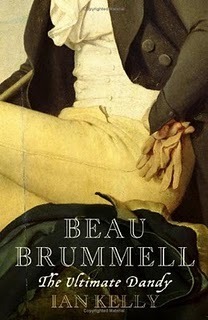
Beau Brummell opened on May 9th 2006 at 59e59 Theater in New York to coincide with the launch of Kelly's biography of Brummell and the Anglomania Fashion Exhibition at the Metropolitan Art Museum.
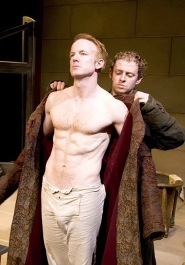
From The New York Times: 'This story of a man who is remembered for his clothes begins with the title character (Ian Kelly) stark naked. He is in the tub, holding a razor to his throat and threatening suicide, but he allows his valet, Austin (Ryan Early), to stop him... Mr. Kelly is extremely funny, engaging and intensely sympathetic as Brummell, tossing out grand observations ("Excess is the antithesis of style," "How can one be lonely with a looking glass?") as if to the manner born while conveying with aching pathos the quiet agonies of a ruined man trying not to see through his delusions.'
In addition to Ian's bringing Brummell to life on both the page and the stage, his bio of The Beau was made into a movie, This Charming Man.
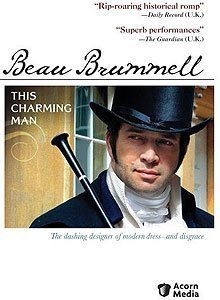
Ian has also written the definitive biography of Casanova, which was named The Sunday Times Biography of the Year.
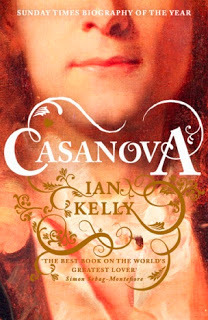
After the performance of The Pitmen Painters, Brooke and I met Ian by the stage door and headed across the street to the Glass House Tavern, where we slid into a semi-circle of a booth, ordered drinks and chatted about books, Brummell and London. Ian - quite tall, incredibly charming and a font of literary information - regaled us with tales of Brummell: the man, the book, the play and the movie. There were aspects of each that he both liked and disliked. While James Purefoy was tapped to play Brummell in the movie, Ian played Robert, one of the "Bad" Manners brothers. Screamingly funny note: On the first day of shooting, the assistant director, who apparently had no idea who Ian was, other than the actor playing Robert Manners, pulled Ian aside and attempted to explain his character to him. Ha!
Look for Ian playing the doctor in Downton Abbey (see tomorrow's post) and as Hermione Granger's Muggle dentist father in Harry Potter and the Deathly Hallows. In fact, the commercial for the film came on when we were together and after watching it, Ian turned to me and said, in best tongue-in-cheek fashion, "Looks like I didn't make it to the trailer." Ian was a bit taken aback when I asked him, apropos of nothing,"So, what's Alan Rickman like?" "I'm sorry," Ian responded after a beat, "Alan Rickman?" "Yes," I clarified, "you know, Snape, in Harry Potter." Turns out that Ian didn't have any scenes with Rickman, but he did tell me that the set designers built the entire Granger house on a London back lot, furnished it to the highest degree of comfort and decoration, used it for his scenes and then dismantled the entire building down to the last nail.
Moving on to books, Ian told us about doing research in the London Library, living in Venice for a while while researching Casanova and about his next biography, due out in 2012. While I can't give the game away, I can tell you that, according to Ian, his subject will be "yet another Georgian bad boy." Hint: think theatre. You can visit Ian's website here.
Published on November 02, 2010 01:55
November 1, 2010
A Decidedly Non-English Visitor
Try as I might, I can't find a way to put a British spin on this post, so I'll just beg your indulgence in order to tell you that my husband and I have recently been blessed by the appearance of a burrowing owl who has taken up residency on our front porch.

You can barely see him (her), but he's standing in the flower pot to the right, behind the white railings.
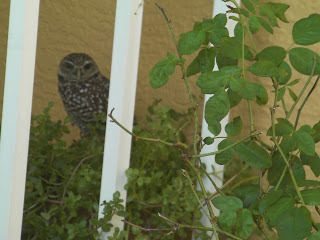
Here's a closer look. True to its name, the Burrowing Owl nests in a hole in the ground. Although it is quite willing to dig its own burrow, it often uses one already provided by prairie dogs, skunks, armadillos, or tortoises. The first published report of the Burrowing Owl was in 1782 by Giovanni Iganzio Molina, an Italian Jesuit priest stationed in Chile.
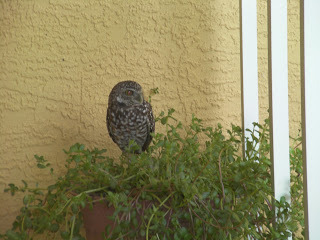
The Burrowing Owl can be seen year-round, day or night, in central and south Florida. They prefer open prairie, but are also found in agricultural, recreational and residential areas. Burrowing Owls are the only North American owl that nests underground, and sometimes they will nest colonially with just a few feet separating each burrow.

Florida Burrowing Owls are state-listed as a species of special concern. Estimates put the Florida Burrowing Owl population at around 3,000 birds. The City of Cape Coral - where we live - claims Florida's largest population of the burrowing owl, and each year holds a Burrowing Owl Festival.
 We've named ours "Ollie."
We've named ours "Ollie."

You can barely see him (her), but he's standing in the flower pot to the right, behind the white railings.

Here's a closer look. True to its name, the Burrowing Owl nests in a hole in the ground. Although it is quite willing to dig its own burrow, it often uses one already provided by prairie dogs, skunks, armadillos, or tortoises. The first published report of the Burrowing Owl was in 1782 by Giovanni Iganzio Molina, an Italian Jesuit priest stationed in Chile.

The Burrowing Owl can be seen year-round, day or night, in central and south Florida. They prefer open prairie, but are also found in agricultural, recreational and residential areas. Burrowing Owls are the only North American owl that nests underground, and sometimes they will nest colonially with just a few feet separating each burrow.

Florida Burrowing Owls are state-listed as a species of special concern. Estimates put the Florida Burrowing Owl population at around 3,000 birds. The City of Cape Coral - where we live - claims Florida's largest population of the burrowing owl, and each year holds a Burrowing Owl Festival.
 We've named ours "Ollie."
We've named ours "Ollie."
Published on November 01, 2010 01:23
October 31, 2010
Jane Austen in Portland OR
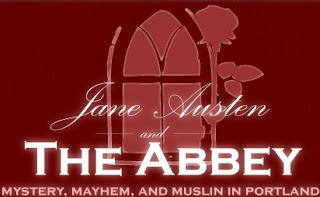 JASNA in Oregon
JASNA in OregonVictoria here with just time for a moment on line before I attend the closing event of the 2010 JASNA AGM. It has been a wonderful conference, started off with a day and a half at the Burney Society conference. I've heard so many excellent presentations that my head is spinning. I promise a full report next week, including lots of photos of last night's Bal Masque, a combination of fabulous regency gowns and men's apparel with some extremely creative costumes, including the Phantom of the Opera, Bottom from Midsummer Night's Dream, and many many more.
 This is my first visit to Portland, a lovely city, with some excellent restaurants. Next year JASNA goes to Ft. Worth, TX, and I hope everyone can come. I will be speaking on Regency Weddings at a pre-conference gala.
This is my first visit to Portland, a lovely city, with some excellent restaurants. Next year JASNA goes to Ft. Worth, TX, and I hope everyone can come. I will be speaking on Regency Weddings at a pre-conference gala.
Published on October 31, 2010 08:52
Depp to Star in Remake of Dark Shadows
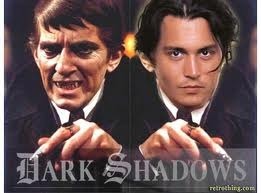
Keeping in the Halloween spirit, I'll tell you that it's been announced that the legendary, and slightly mad, director Tim Burton has signed Pride And Prejudice And Zombies writer Seth Grahame-Smith to adapt the late '60s horror-soap-opera Dark Shadow into a film starring the slightly mad Johnny Depp. Apparently, Grahame-Smith was offered the job because Burton enjoyed his lesser known zombie-history novel Abraham Lincoln: Vampire Hunter. In fact, Burton liked it so much that he bought the rights and Burton is currently in pre-production on the film version of that novel.
In the movie version of the of Dark Shadows, the cult vampire daytime soap opera that ran from 1966 to 1971, Depp is set to play the lead Barnabas Collins, who throughout the show's 1200 episodes experienced storyarcs including time travel, parallel universes, and encounters with many things that went bump in the night. Shooting on the film is slated to begin in January 2011 and this project will be the eighth collaboration for Depp/Burton, who last teamed up on Alice in Wonderland, a film not meant to be viewed without 3-D glasses and/or copious amounts of mind altering substances. Meanwhile, Depp is currently filming the next Pirates of the Caribbean installment.
Amazingly, actor Jonathan Frid, who played Barnabas Collins in the television show, is still alive and kicking and has his own website. And here I thought he'd only played a vampire.
Trick or Treat . . . . . .
Published on October 31, 2010 02:58
October 30, 2010
Victorian Mourning Photography
There was a period of a few years when I couldn't go anywhere without falling over mourning related items. In an antique shop in Nassau in the Bahamas (!?) I found a complete issue of the London Illustrated News covering the Duke of Wellington's funeral.
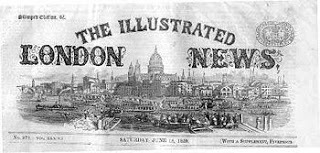
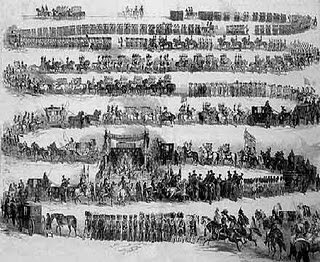
A drawing from the Illustrated London News of the Duke's funeral procession.
And I found the issue below focused on the death of Queen Victoria while in England.
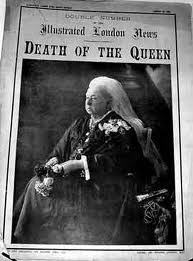
In addition, I regularly found mourning photographs, or postcards, featuring royal figures. The advent of photographs, and especially daguerreotypes in 1839, made portraiture available to everyone and it was soon adapted for mourning purposes, with Queen Victoria embracing the medium wholeheartedly. Due to published images of Queen Victoria and her family in mourning for Prince Albert like those below, it soon became the vogue to have photos made of oneself in mourning.
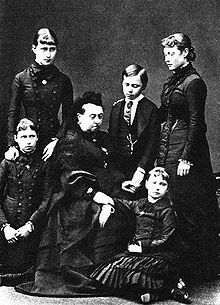
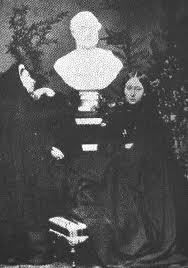
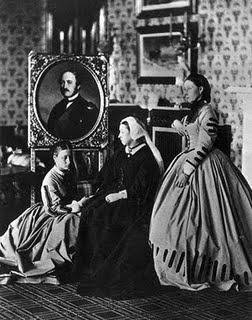
In addition, the old fashioned mourning, or momento mori, memorabilia issued upon the deaths of public figures also adapted photographs into their designs.
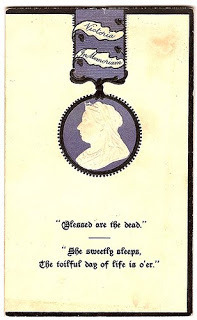
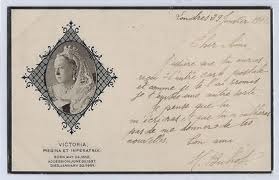
Photographs were also taken during public funerals, like that for Queen Victoria below.
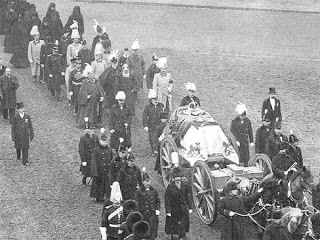
When Napoleon III died, the Illustrated London News of January 25, 1873 ran the following engraving, which was drawn from a post mortem photograph taken by Mssrs. Downey. By this time, photographs of mourners and funerals had taken a back seat to photographs of the dead themselves.
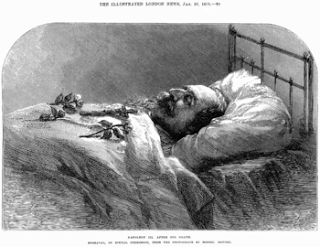
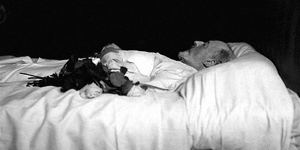
This is one of several postcard photos of Edward VII from my collection and it was the first time I'd been confronted with an actual photograph of a corpse, albeit a royal one. It prompted me to do more research into the topic and, while I initially found the photo of the dead king unsettling, I now see it as downright benign when compared others that exist.
Warning: While I've decided not to include the most unsettling mourning photographs I've found in this post, the following images were chosen as representative of the genre and may still prove disturbing to some viewers.
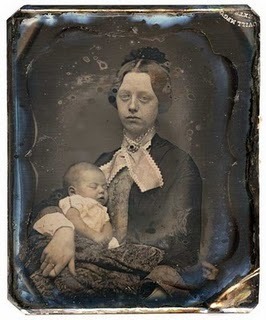
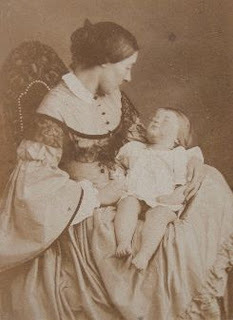
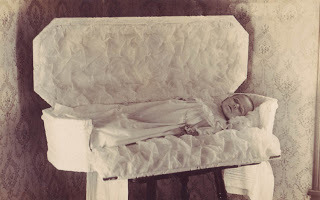
Whilst the very nature of these photographs is decidedly creepy, one can understand a mother, or father, wanting such a rememberance of their child. However, the very nature of these photographs also lends them a macabre air, often helped along by the composition used by the photographer. The photograph below looks like a piece of promotional material from The Shining Four.
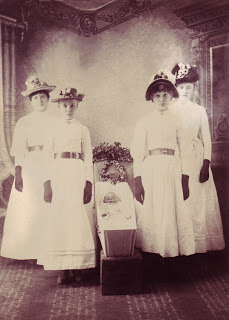
On a creepiness scale of 1 to 10, it rates a 15.
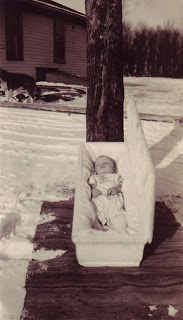
This photo is just inexplicable.
Disturbing as photos of prepared corpses may be, they are far more understandable than the photos taken of the dead who have been placed in various poses, such as the one below.
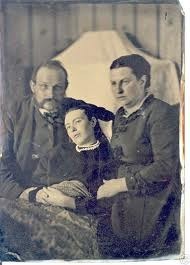
I chose to use this photo of parents sitting on either side of their deceased daughter as representative of the posing of the dead since it's the least offensive. There are photographs of children and adults propped up in attitudes of play and in prayer. There's a particularly macabre photo of a dead fireman who has been propped up on a stand like a mannequin, dressed in uniform and wearing his hat. All of these photos have one thing in common - it is evident in each that the subject is deceased. The "lifelike" poses aren't fooling anyone. In some cases, the dead, white, unseeing eyes of the subject aim straight at the camera. And lest you think that mourning photography was confined to humans, here is a Victorian photograph of the pet cemetary in London's Hyde Park.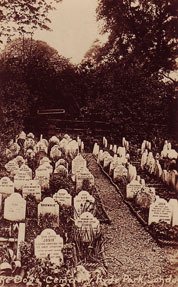
And here is another photo of four grieving women, this time mourning a dog and looking much less creepy than the four females in the previous photo above.
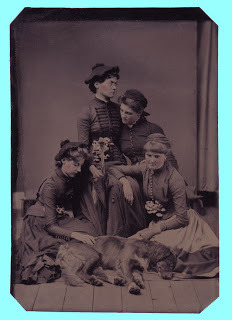
Should you wish to see the mourning photos I chose not to use in this post, visit photographer Paul Frecker's site here and a gallery hosted by the Museum of Mourning Photography here.


A drawing from the Illustrated London News of the Duke's funeral procession.
And I found the issue below focused on the death of Queen Victoria while in England.

In addition, I regularly found mourning photographs, or postcards, featuring royal figures. The advent of photographs, and especially daguerreotypes in 1839, made portraiture available to everyone and it was soon adapted for mourning purposes, with Queen Victoria embracing the medium wholeheartedly. Due to published images of Queen Victoria and her family in mourning for Prince Albert like those below, it soon became the vogue to have photos made of oneself in mourning.



In addition, the old fashioned mourning, or momento mori, memorabilia issued upon the deaths of public figures also adapted photographs into their designs.


Photographs were also taken during public funerals, like that for Queen Victoria below.

When Napoleon III died, the Illustrated London News of January 25, 1873 ran the following engraving, which was drawn from a post mortem photograph taken by Mssrs. Downey. By this time, photographs of mourners and funerals had taken a back seat to photographs of the dead themselves.


This is one of several postcard photos of Edward VII from my collection and it was the first time I'd been confronted with an actual photograph of a corpse, albeit a royal one. It prompted me to do more research into the topic and, while I initially found the photo of the dead king unsettling, I now see it as downright benign when compared others that exist.
Warning: While I've decided not to include the most unsettling mourning photographs I've found in this post, the following images were chosen as representative of the genre and may still prove disturbing to some viewers.



Whilst the very nature of these photographs is decidedly creepy, one can understand a mother, or father, wanting such a rememberance of their child. However, the very nature of these photographs also lends them a macabre air, often helped along by the composition used by the photographer. The photograph below looks like a piece of promotional material from The Shining Four.

On a creepiness scale of 1 to 10, it rates a 15.

This photo is just inexplicable.
Disturbing as photos of prepared corpses may be, they are far more understandable than the photos taken of the dead who have been placed in various poses, such as the one below.

I chose to use this photo of parents sitting on either side of their deceased daughter as representative of the posing of the dead since it's the least offensive. There are photographs of children and adults propped up in attitudes of play and in prayer. There's a particularly macabre photo of a dead fireman who has been propped up on a stand like a mannequin, dressed in uniform and wearing his hat. All of these photos have one thing in common - it is evident in each that the subject is deceased. The "lifelike" poses aren't fooling anyone. In some cases, the dead, white, unseeing eyes of the subject aim straight at the camera. And lest you think that mourning photography was confined to humans, here is a Victorian photograph of the pet cemetary in London's Hyde Park.

And here is another photo of four grieving women, this time mourning a dog and looking much less creepy than the four females in the previous photo above.

Should you wish to see the mourning photos I chose not to use in this post, visit photographer Paul Frecker's site here and a gallery hosted by the Museum of Mourning Photography here.
Published on October 30, 2010 02:38
October 29, 2010
A Macabre Look at Death Masks
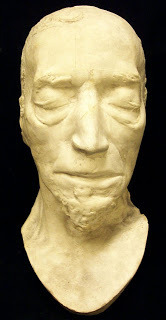 Benjamin Disraeli
Benjamin Disraeli
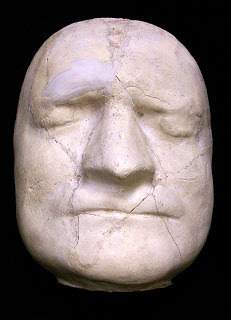 Sir Issac Newton
Sir Issac Newton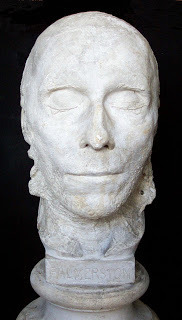 Viscount Henry Palmerston
Viscount Henry Palmerston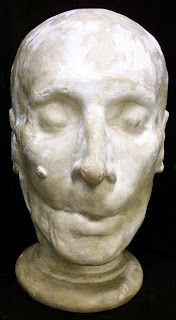 Richard Brinsley Sheridan
Richard Brinsley SheridanRecently, I came across a book online called The Laurence Hutton Collection of Life and Death Masks: A Pictorial Guide by John Delaney, held in the Manuscripts Division in the Department of Rare Books and Special Collections at Princeton University Library. The making of death masks became popular in the 1800s, but the practice has much older roots. The first masks and effigies made in wax directly from the features of the deceased date from medieval Europe. Personally, I don't get death masks. All of the people from whom death masks were taken were prominent people who had had numerous portraits and busts taken during their lifetimes. Why not remember them thusly, in the prime of their lives, rather than take an image of them in old age - withered, toothless and, more often than not, after having just suffered hours of agony? Perhaps my aversion to death masks is a woman thing. After all, I've yet to come across the death mask of a female.
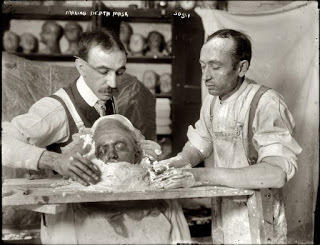 Making a plaster death mask, New York circa 1908, George Grantham Bain Collection, Library of Congress
Making a plaster death mask, New York circa 1908, George Grantham Bain Collection, Library of CongressI'd much rather remember, and hang on my wall, a picture of the Duke of Wellington looking like he does in the banner of this blog rather than like this:
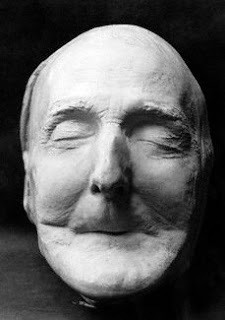
The Duke of Wellington
In a volume titled, "The life of Richard Owen", by Rev. Richard Owen (1894) there is reference to the death mask above in a letter written on November 13, 1852, to Mr. Thomas Poyser, of Wirksworth :" I have been particularly favoured in respect of the remarkable solemnities in honour of the memory of the great Duke. The present amiable inheritor of the title called on me last Wednesday to request that I would call on him to see the cast that had been taken after the Duke's demise, and give some advice to a sculptor who is restoring the features in a bust, intending to show the noble countenance as in the last years of the Duke's life. It is a most extraordinary cast. It appears that the Duke had lost all his teeth, and the natural prominence of the chin and nose much exaggerates the intermediate space caused by the absorption of the alveoli. He of course wore a complete set of artificial teeth when he spoke or ate. My last impression of the living features is a very pleasing one. I brought it away vividly in my mind from Lord Ellesmere's great ball last July."
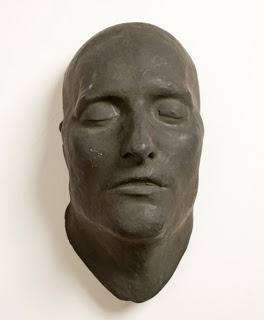 Napoleon's Death Mask
Napoleon's Death MaskOr is it? Is this the face of a short and rather dumpy fifty-one year old man? Napoleon died on May 5th, 1821, on the small island of St. Helena where he had been exiled for life after his shattering defeat at the Battle of Waterloo in 1815. A cast for a death mask was made by Dr. Francis Burton within a day and a half of Napoleon's death. But, there was another doctor present at the time of Napoleon's death, Dr. Antommarchi, who some say was mistakenly credited as the doctor who made the original mold. Immediately after the cast was made, it was stolen. It is believed that a woman named Madame Bertrand, Napoleon's attendant, took the mold and sailed back to England. Dr. Burton tried but was unsuccessful in getting the cast back. Several years later a death mask turned up and was authenticated as being the original by Dr. Antommarchi, though historians have always argued against it, as the Antommarchi mask looked much too young to have been Napoleon, no to mention that bones of the face are heavier, the face itself longer and proportionally different when compared to the portraits that had been painted of the Emperor Napoleon. It is the official mask currently on display at Les Invalides in Paris, France.
Some believe that the death mask above was actually molded from the living face of the Emperor's valet, Jean-Baptiste Cipriani.
This is the mask that is thought to be authentic:
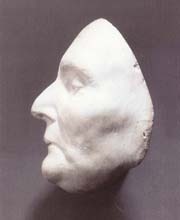
This death mask was on display at the Royal United Services Institute Museum in London for many years prior to 1973, when the mask was sold. You decide . . . . . here is one of the last portraits of Napoleon, painted by Sir Charles Lock Eastlake on board the ship Bellerophon.
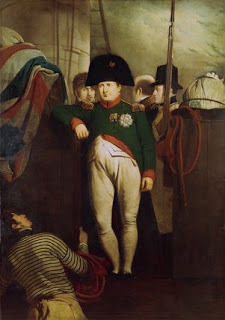
And here is an enlargement of the face
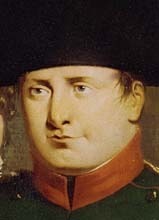

Viola. Ze case it has rested. At least in my mind.
And the strange tales concerning death masks continue - It seems that there was once a special tunnel used to transport the bodies of the hanged from Worcester Gaol to the nearby Royal Infirmary, which stood across the road from the prison and has since been demolished. Until 1832, only criminals' bodies were allowed to be dissected for medical research in the UK. The tunnel was found during work to transfom the former hospital into the new campus for the University of Worcester in the 1950's - as were a number of death masks in the tunnel. These casts had been made to study the characteristics of the criminals' personalities using physiognomy (shape and size of the head) and phrenology (study of the site of different abilities on the head), once thought to be useful in predicting criminal behaviour. The masks are now on display at the George Marshall Medical Museum in Worcester.
Perhaps the strangest story concerning a death mask - and physiognomy - is that involving Gershon Evan, who went on to live another 64 years after his mask was taken. In September 1939, 16 year old Evan was arrested along with 1,000 other young Jewish men and taken to Vienna's Prater Stadium, where all were detained for weeks. Seeking out those with classic "Semitic" features, Nazi scientists — a commission of the anthropology department of the Natural History Museum — selected 440 men for study. Hair samples, fingerprints, hereditary/ biological appraisals and numerous photographs of the men were taken. The length and width of their noses, lips, chins and other facial features were meticulously documented. Evan was one of them. Soon after, Evan was ordered to submit to having a death mask taken.
"My head on the pillow, I stretched out on the table and closed my eyes," he recalled in his memoirs years later. "The man advised me to relax, while he coated my face with a greasy substance. He applied it from the top of my forehead down to the throat and from ear to ear. The lubricant, he explained, was to prevent the hardened plaster of Paris from sticking to my skin." At the end of the procedure, the death mask was removed, catalogued and archived. Evan was given a single cigarette for his troubles before being moved to Buchenwald, from where he was miraculously released four months later. At age 80, Evan was shown his preserved death mask and barely recognised himself in the youthful face held between the hands of a museum curator.
For more on death masks, including instructions on how to make one, visit Carlyn Becchia's Raucous Royals blog.
Published on October 29, 2010 01:53
October 28, 2010
Mary Anne Clark by Jo Manning - Part Four
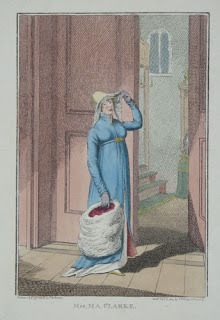
Mrs M.A.Clarke, as drawn & engraved by C.Williams, published Feb 25, 1809 by S.W.Fores, 50 Piccadilly
In the above print, titled "Committee of Inquiry" (available for £180 @Grosvenor Prints in Hampton, Middlesex), the descriptive text from Grosvenor Prints has Mrs. Clarke "standing in the lobby of the House of Commons, a section of which is seen through the partly open door: the corner of three tiers of empty benches and the gallery, with a strip of the Speaker's chair, showing his right elbow." Mrs. Clarke wears a blue pelisse over a simple white dress; on her head rests a straw bonnet with a lace veil. With her left hand she raises the hat's veil from her face. The very, very large object on her right hand is a fur muff. Again, as per the description, "She is elegant, alluring, and assured."
But where was Mary Anne Clarke during the period of the trial and through 1813, when, under the terms of her annuity from the Duke of York, she had to leave England for the Continent?
In her questioning at the 1809 trial she stated that she was a widow living in "Loughton Lodge, in the county of Essex." So, apparently – or, according to her – her husband, Joseph Clarke, the philandering drunkard, is deceased. But was she actually living where she said she was? The truth and Mary Anne Clarke were never friends, so some skepticism is in order.
According to an article by one Richard Morris in the March/April 2008 newsletter of the Loughton Historical Society, there are some doubts as to her residence in the area at all, though Morris, covering his bases, does write at the end of his piece:
"I am, however, convinced that there must be some truth in the story, if only because of Daphne du Maurier's relationship to Mary Anne Clarke, her reputation as a novelist, the research she did for her book, and the many references in it to Loughton and Loughton Lodge."
Bless the man, to have such faith in an author's research! But we know from what Du Maurier said in the preface to her novel Mary Anne that she relied on someone's "notes" and on the library research of two others. Dicey. So, here's the dubious part:
"There are in total nine references to Loughton in [the] novel, and one refers to Mary Anne Clarke looking out of the window at Loughton Lodge: 'at the neat box-garden, the gravel drive, the trim smug Essex landscape'. This can only considered as author's licence as Loughton Lodge stands on top of Woodbury Hill with its front facing what is now Steeds Way…in 1809 [it] would have given clear views over the Roding Valley and beyond, and the rear which overlooks an attractive part of the Forest."
The reference in the last line is to Epping Forest, a considerable parcel of wooded area. Hard to overlook.
Morris goes on to say that he can find no specific evidence of Mary Anne Clarke's time in Loughton, even though a local street – in acknowledgement of her supposed time in the town -- was changed from Mutton Row to York Hill in 1850. When Mary Anne was supposedly in residence at Loughton Lodge, though, it belonged to a family named Shiers. True, she could have been a lodger at the Lodge, but lodging in someone else's digs was never Mary Anne's style.
And what of this Loughton Lodge today? Turned into an old folks' home after World War II, it was subsequently divided into two separate houses. I have not been able to find an image of it, either as it was then, or as it is today. Nor was I able to verify that "a blue plaque" was affixed to the building in April of 2009. In 1811, wherever Mary Anne was, she did one other thing for posterity, that is, she commissioned the Irish-born sculptor Lawrence Gahagan to sculpt a marble bust of her (now in London's National Portrait Gallery). It's very beautiful.
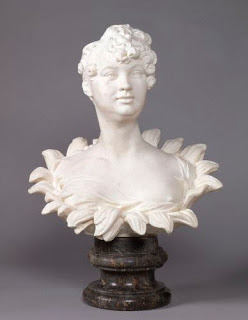 Mary Anne Clarke rises from the open petals of a sunflower. She's thought to represent Clytie, the abandoned lover of the sun god, Helios, changed into a sunflower so that she could follow her perfidious lover's progress across the sky each day
Mary Anne Clarke rises from the open petals of a sunflower. She's thought to represent Clytie, the abandoned lover of the sun god, Helios, changed into a sunflower so that she could follow her perfidious lover's progress across the sky each daySo, we come to the question… Do all old English courtesans die impoverished – and disgraced -- in France? Grace Dalrymple Elliott died there, in the village of Meudon, and, if not in poverty, close to it; Dorothy Jordan definitely died in awful poverty in Saint-Cloud; Mary Robinson didn't die in France – she died at home, in England -- but she died as poor as it was possible to be; likewise Emma Hamilton, who met her sad demise in Calais.
And then there's Mary Anne Clarke. Yes, she died in France – after extensive travels through Italy and Belgium -- in Boulogne-sur-Mer, but decidedly not in poverty. That generous annuity from the Duke of York saw her through, as it did her daughter Ellen Clarke Busson du Maurier, who raised her family on it.
The irony – there's always the irony – is that poor Ellen Clarke (said to be as unattractive as her mother was beautiful, with sallow skin and sharp features) apparently was under the illusion for years that she was the by-blow of the Duke of York, but though she was probably not the daughter of her mother's husband Joseph Clarke, neither could she have been the daughter of Frederick. Her mother – though she certainly knew many men intimately between Clarke and Frederick – did not meet the Duke of York until Ellen was at least six years old. Her biological father is a mystery.
Ellen, so unlike her mother in every way – save perhaps for the sharpness of her tongue -- married the inventor Louis-Mathurin Busson du Maurier, a charming, talented dreamer (said to have a beautiful singing voice) who never amounted to anything and was prone, as were others in his family, to depression. His so-called inventions were laughable and he was forever in debt. Although it appeared to have been a love-match, it was disastrous. Ellen had to borrow from her mother and her sister-in-law Louise all her married life. When she came into the annuity in 1852 – either in whole or in part -- upon the death of Mary Anne Clarke, she still found it difficult to make ends meet, as her children seemed to have a hard time making decent livings.
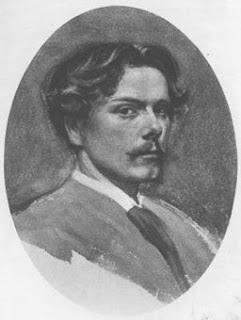
George Du Maurier, author of Trilby
Late in his life, however, her eldest child, and her favorite, George Du Maurier, became a successful cartoonist for Punch and other political publications of the day, and, at age sixty, he wrote a bestselling novel, Trilby, inspired by his experiences as an art student in Paris. His son, Gerald Du Maurier, the well-known actor-manager, was the father of Daphne Du Maurier. (There is a marked resemblance in the image above between George and Daphne. Look at their noses.)
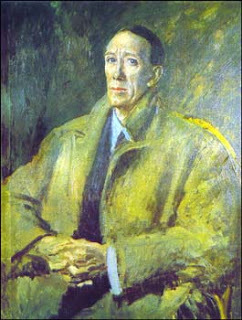
Gerald Du Maurier, respected actor-manager and father of Daphne Du Maurier, by Augustus John
Quite a legacy, this of the Busson du Mauriers and the Clarkes. It was a spirited one, for sure, thanks largely to Mary Anne. Daphne Du Maurier, whose attitude towards her ancestor I find somewhat ambivalent, summed up this legacy in The Du Mauriers:
"The pleasant, sweet-natured, melancholy Bussons of Sarthe had not such fortitude. These fighting qualities were bequeathed…by a woman, a woman without morals, without honour, without virtue, a woman who had known exactly what she wanted at fifteen years of age, and, gutter-born and gutter-bred, treading on sensibility and courtesy with her exquisite feet, had achieved it laughing – her thumb to her nose."
As for the blog post by Kristine comparing Sarah Ferguson, Duchess of York, to Mary Anne Clarke? Mary Anne could have taught her a thing or two, methinks. Yes, Mary Anne was as greedy as they come, but she was a whole lot smarter and a good deal more conniving. The greed and love of luxury ultimately brought her down – as, indeed, it appears to have brought down this 21st century Duchess – but, while Mary Anne was down, dear readers, she was never really out. The spunky baggage was a survivor, as so many of her courtesan sisters were not. A dreadful woman, but one has to admire her survival skills. I think that, in the end, her great-great-grand-daughter surely did.Her last words to her son and daughter-in-law were said to be, "It is high time we had another party."
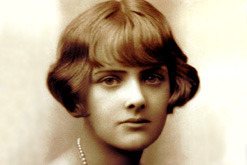 The novelist Daphne Du Maurier as a young woman
The novelist Daphne Du Maurier as a young womanThe End
Published on October 28, 2010 02:26
Kristine Hughes's Blog
- Kristine Hughes's profile
- 6 followers
Kristine Hughes isn't a Goodreads Author
(yet),
but they
do have a blog,
so here are some recent posts imported from
their feed.



